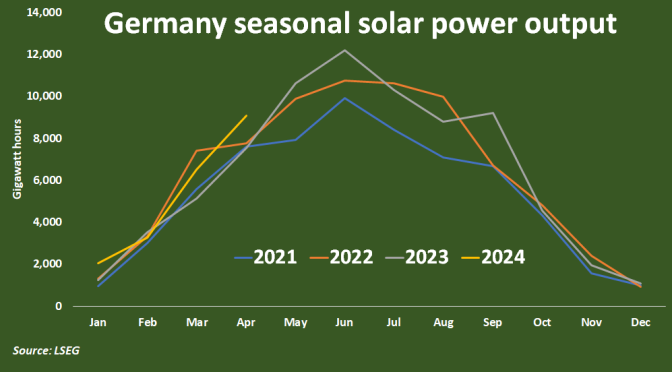Photovoltaics produced more than 60% of Germany’s electricity for several hours a day over the past week, as sunlight combined with new solar generating capacity helped accelerate the country’s energy transition away from fossil fuels. .
During the week ending May 13, Germany’s solar parks produced 17,531 megawatt hours (MWh) of electricity, according to LSEG data, up 40% from the previous week and almost 50% above the long-term average. .
At 1 pm. In Germany on May 13, solar assets produced 43.8 gigawatts (GW) of the 72.4 GW of electricity generated in Germany at that time, according to electricmaps.com.

That means solar power accounted for almost two-thirds of Germany’s total electricity production during that hour, far outstripping production from all other sources, including 17% from wind farms and a combined 12% from coal and coal plants. natural gas.
The high deployment of domestically produced clean energy marks a significant improvement in the state of Germany’s energy sector, which was hit hard by the Russian invasion of Ukraine in 2022.
Germany got about 45% of its electricity from fossil fuels in 2022, so in the year or so following the Russian invasion of Ukraine, the resulting cuts in natural gas flows hurt Germany’s largest energy users.
German production of chemicals and fertilizers, which are energy-intensive sectors, plummeted to multi-year lows in late 2022, as rising energy costs and natural gas shortages forced companies to reduce production. production.
He maintains that a combination of the two businesses would provide significant value for shareholders.
But as growing local renewable energy production helped power prices return to long-term averages in 2023, some of the cost pressures on Germany’s manufacturing base eased, spurring an uneven production recovery. industrial so far in 2024.
That recovery could be further aided by any sustained increase in German solar production, especially if accompanied by additional production from other clean energy sources that could put further pressure on regional energy costs.
As a result of the high proportion of clean energy in Germany’s generation mix, the carbon intensity of the country’s electricity sector during the 1 p.m. time (local time) on May 13 was 166 grams of carbon dioxide per KWh, according to electricmaps.com.
That total compares to 314 g of CO2/KWh for the month of April and 425 g of CO2/KWh for 2023 as a whole.
While the carbon intensity generated by power in Germany far exceeds the roughly 45 g CO2/KWh of France’s heavy nuclear system, the reading of 166 g at 1 p.m. on May 13 was below the 170g CO2/KWh emitted during the same hour in Britain, which has a much lower annual carbon intensity than Germany.
In the future, increased solar production will help to further reduce Germany’s average carbon intensity, especially during the annual period of peak solar generation, around June and July.
In 2023, total generation from Germany’s solar assets peaked in June at 9.41 terawatt hours, according to Ember.
That total generation was 60% greater than the volume produced during April of that year, Ember data shows.
In 2024, total German solar production in April was 7 TWh, so if production in June expands by a further 60%, a new record of 11.2 TWh of generation would be reached this year.
Additionally, solar energy accounted for a record monthly share of 27.3% of total electricity generation in June 2023.
In 2024, if the recent streak of bright, sunny skies persists, solar assets could surpass that previous share record and potentially account for about a third of the country’s total electricity generation during the height of summer.


